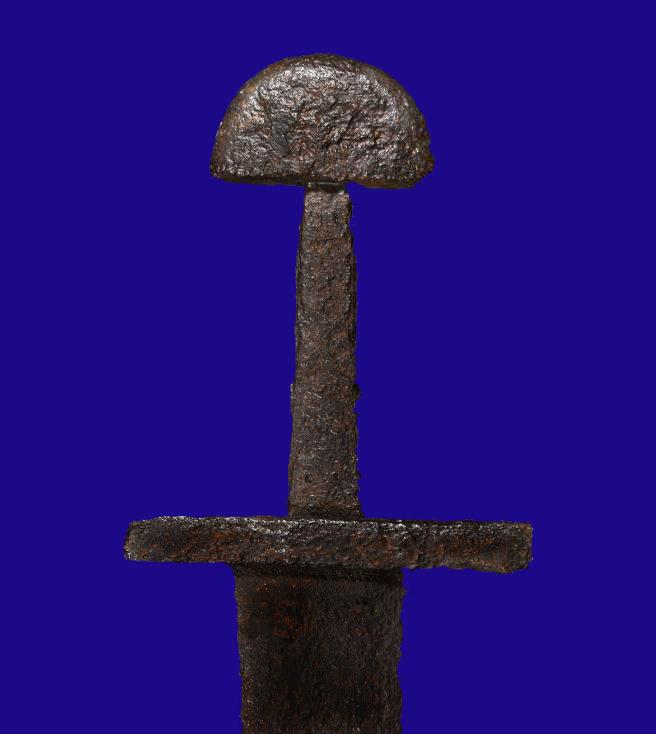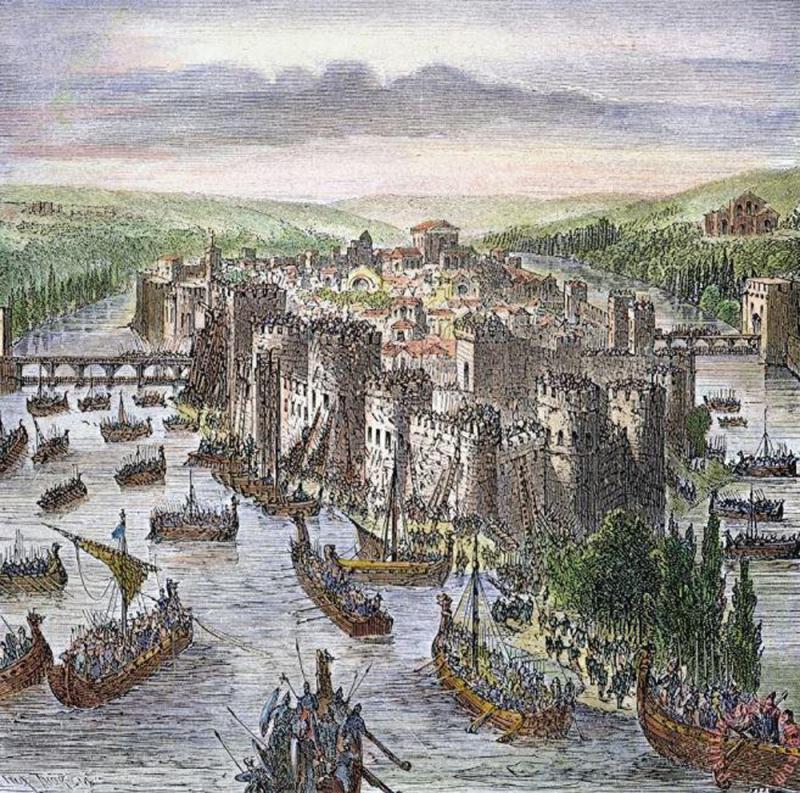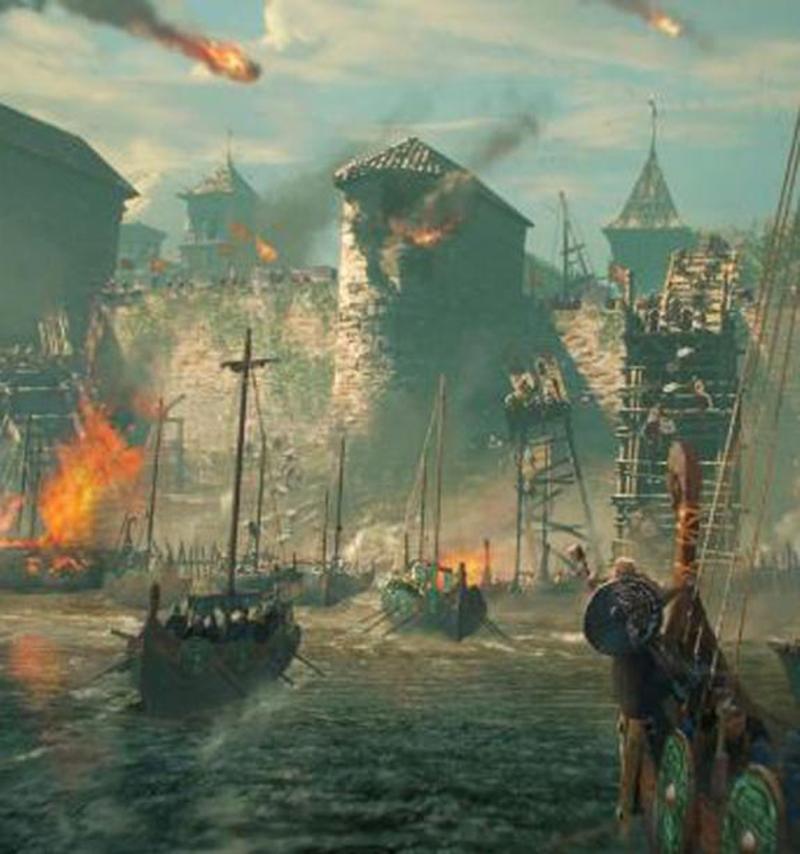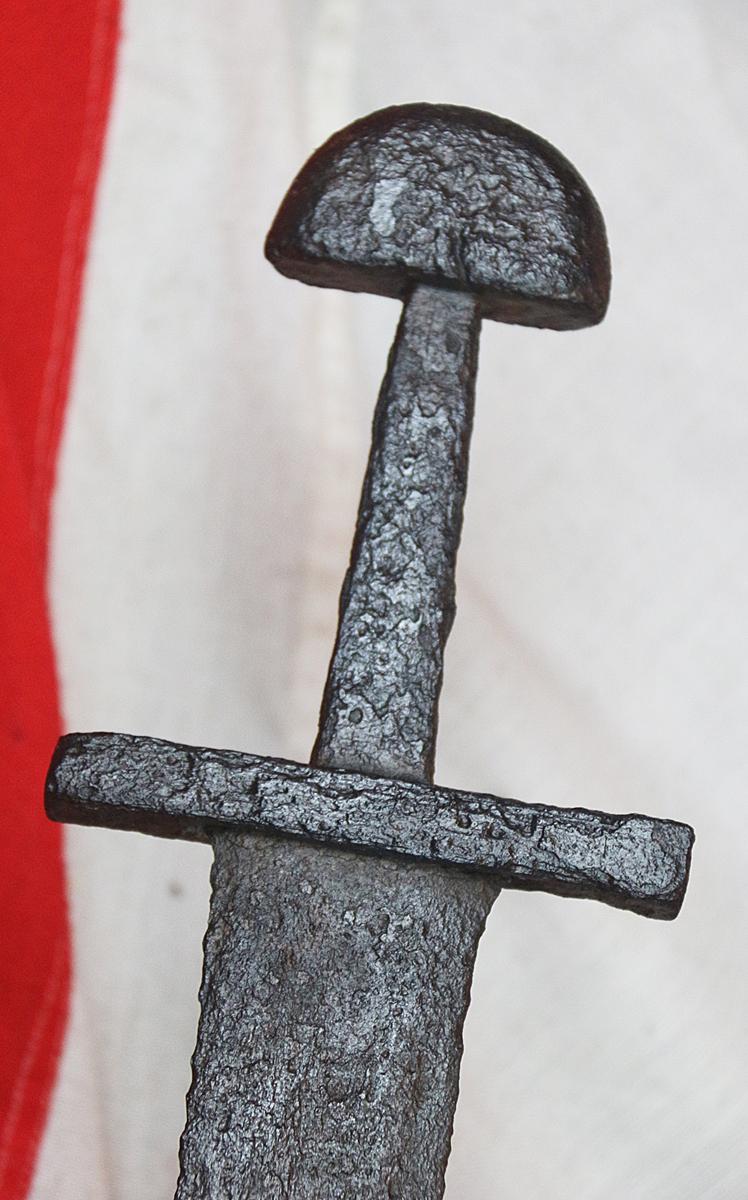A Beautiful Ancient Original Viking Broadsword, From The Era Of The Norsemen’s Raids in Northern France, Around 1150 Years Ago & Their Raids Upon England & Ireland Up To The 11th Century.
A fabulous new addition to our gallery of amazing original ancient artefacts, with an incredible cache of arms and artefacts that have just arrived, from the past 3400 years of warring history, from the Ancient empires of Greece, Macedonia and Rome period, and up to the Viking age of over 1000 years past.
A wonderful example piece, from the ancient Viking Norsemen age. It is said that the Viking sword occupied the highest rank of esteem in the forms of weaponry during the entire Viking age. It was certainly not a common weapon for the regular Viking warrior. Only the Viking's of superior rank, power or status could afford the finest craftsmanship as was found in the sword. The more usual weapons in the Viking warrior community, especially for the regular warrior were axes and spears.
This sword, that is codified as a Petersen type X, was popular and used predominantly from the mid to late 800's to the 11th century. The D shaped pommel, which acted as a counterweight to the blade, so that the sword balanced, could display inlays of precious metals or intricate patterns. The blade itself often had so called “blood grooves” or fullers, and this sword has a single fuller running along its middle. These fullers saved valuable metal and made the sword lighter. A sword might be the most expensive item that a man owned. The one sword whose value is given in the sagas (given by King Hákon to Höskuldur in chapter 13 of Laxdæla saga) was said to be worth a half mark of gold.
There is a near pair to this sword in the Paris Museum collection, as Northern France, Brittany and Normandy were some of the great areas of battle and conflict for the Viking Norsemen, with thousands eventually settling in Normandy to become what today is known as the Normans. The great seiges of Paris, and where the formidable Vikings looted and plundered the north of France are legendary, and from whence they gained massive tribute from the resident Kings of the Franks to bribe them to cease their sieges and destruction.
There were two famed Norse sieges of Paris. The first was in 845; and though a fairly minor affair in terms of battle, it had great symbolic significance. The second was roughly two generations later, in 885-886; was much larger (and deadlier); and had greater direct ramifications. Before the first siege, Viking raids were a new and growing problem for the peoples of Western Europe; but hitherto raids had been made by relatively small war bands bent on plunder. The Scandinavian adventurers might sack monasteries or villages, but would usually shun larger, better defended targets. However, success was making the Norsemen bolder.
Aware of this growing threat, the ageing emperor, Charlemagne, built a series of maritime defences to protect his coasts and rivers from these new dragon ships. For the first few decades, the defences worked; but the Vikings were growing in number, ability, and ambition and a new breed of leaders was coming to the fore. One of these leaders was a man the Frankish chroniclers call Reginheri; but who has since been widely equated with the semi-legendary figure Ragnar Lothbrok. Under Ragnar, Vikings were ready to step foot on the world stage. They were ready to capture the jewel of Western Europe, the city of Paris.
So, in Spring of 845, 120 dragon ships carrying about 5000 Scandinavian warriors, broke through the late emperor’s defenses and surrounded the walled city of Paris. In the ninth century, Paris was already more than a thousand years old. It was wealthy from its position as a trading centre, and was the seat of one of Charlemagne’s three competing heirs, Charles the Bald. At this time, the heart of the city was confined to the islands in the centre of the Seine, the Île de la Cité where the cathedral of Notre Dame stands today. This position made Paris eminently defensible in the eyes of the Frankish elite that ruled there; but it made it easily surrounded by the ship-born Vikings.
Not a very good tactician at this time, Charles the Bald (Charlemagne’s grandson, who in all fairness, was only about 22 and new to his position as king) split his forces between the two banks of the Seine in order to better defend the nearby Abbey of Saint Denis. Ragnar’s Danes concentrated their attack on the forces on one bank of the Seine and easily defeated the Franks. They took 111 Frankish prisoners in the battle (this relatively small number further emphasises the Frank’s level of surprise and unpreparedness). In full view of the city and the army on the opposite river bank, the Vikings further terrified their foes by hanging all 111 prisoners as a sacrifice to Odin. The Vikings then moved on Paris and captured it with equal efficiency .
Faced with these appalling developments, Charles took a course of action that was as practical as it was controversial (both at that time and ever after). He offered Ragnar 7000 livres (more than 5600 pounds) in gold and silver to take his men and leave. This cash pay-out became the first of many, many Danegelds (roughly translated, “gold to the Danes” that the princes of Europe would offer Viking armies to leave them alone ). To pay such a tremendous sum to “heathen savages” must have been a brutal humiliation for the grandson of the man who united most of Western Europe under his implacable will; but Charles was already facing rebellion in Aquitaine and Brittany, and had no wish to risk his troops, the citizens of Paris, or the religious and cultural treasures of the several nearby abbeys in a prolonged battle he would likely lose. His hands were tied, and so he paid.
Swords were heirlooms. They were given names and passed from father to son for generations. The loss of a sword was a catastrophe. Laxdæla saga (chapter 30) tells how Geirmundr planned to abandon his wife Þuríðr and their baby daughter in Iceland. Þuríðr boarded Geirmund's ship at night while he slept. She took his sword, Fótbítr (Leg Biter) and left behind their daughter. Þuríðr rowed away in her boat, but not before the baby's cries woke Geirmundr. He called across the water to Þuríðr, begging her to return with the sword.
He told her, "Take your daughter and whatever wealth you want."
She asked, "Do you mind the loss of your sword so much?"
"I'd have to lose a great deal of money before I minded as much the loss of that sword."
"Then you shall never have it, since you have treated me dishonourably The Vikings placed such status on to their swords they often named them, due to the belief of their supposed magical qualities, heritage, and creator of remarkable events. Such evocative names as;
Gramr: Fierce. This was the name of the sword that hero Sigurd used to kill the dragon Fafnir
Gunnlogi: Battle Flame, War Flame
Leggbir: Leg bitter
Skrofnung: Gnawer
Keurnbut: Millstone-breaker
Naegling: Hole-maker
Fotbitr: Foot-biter.
Swords that had names were a treasure not only for their monetary value but also for the honour for the family and the clan.
This is in very good condition for age, and feels just as a fine top quality sword should, even today. It was likely used up to, and into, the 11th century British 'Battle of Hastings' era of 1066, known as the the Norman invasion period. Swords from the 10th to the 12th century of British history, used in the Battle of Hastings invasion period and into the earliest part of the new British Norman age, and it was used by the invading Norman knights who were settled Vikings, that ruled England after conquering the Anglo Saxon King Harold.
This fabulous, historical Viking sword, has the highly iconic, and typical fashion, double-edged broad sword, and hilt of Petersen Type X, with a tapering blade, shallow fullers, possible traces of pattern-welding to the blade, it has superb battle nicks to both cutting edges; an a. rectangular crossguard
See Petersen, J., De Norske Vikingsverd, Oslo, 1919; Peirce, I., Swords of the Viking Age, Suffolk, 2002; Hiardar K. and Vike, V., Vikings at war, Oxford-Philadelphia, 2016; the sword has good parallels with similar Viking age specimens published by Peirce (2002, pp.102-105), one in the British Museum and the other at the Universitetets Oldsaksamling, Oslo.
Footnotes
Viking swords of Type X are commonly found in Nordic countries and Europe, with a number found in Western Europe, France England and Ireland. In the gallery we show an original medieval painting of 11th century King Harald in combat at Stamford Bridge in 1066.
In the Church of Rønninge stands a rune stone bearing the text: “Sóti placed this stone in memory or Eileifr, his brother, Ásgautr Red-shield’s son”. Nearby lies the Rosenlund grave containing weapons and riding equipment, perhaps it was Ásgautr’s grave. We are familiar with Viking swords from various burials, which mainly date to the early Viking period. It was most often people of high status who were buried with swords in the Viking Age. Not all Viking warriors had a sword; they were prestige weapons. Swords were highly valued objects and could be handed down from generation to generation. They were also given as gifts to people of high status in order to stay on good terms with them.
Viking swords were also used in another way. This was the tradition of sacrificing the valuable swords in lakes and bogs. Many swords, spears and lances from the Viking and early medieval periods have also been found near fords crossing rivers and in wetlands. Perhaps the weapons were left at such locations as an offering, or else they were simply dropped and lost during the attempt to cross the water. Almost every weapon that has survived today from this era is now in a fully russetted condition, as is this one, because only very very few of the swords of kings, that have been preserved in national or Royal collections are today still in a relatively good state and condition We will include for the new owner a complimentary wooden display stand, but this amazing ancient artefact of antiquity would also look spectacular mounted within a bespoke case frame, or, on a fine cabinet maker constructed display panel. Extremely similar to a pattern-welded sword found with a large number of other objects, at Camp de Péran, Côtes-d'Armor, France, in a 10th century context, probably linked with the early Norman settlers in Normandy or Norman raids in Brittany (Roesdhal, Wilson, 1992, p.321, cat. n.359; Renaud, 2000, p.100).
Overall length 36.25 inches {925mm} 30.5 inches {770mm} crossguard 5 inches {128mm}
As with all our items it comes complete with our certificate of authenticity.
Code: 24770







